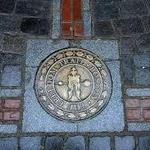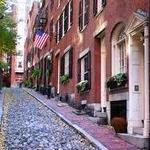Seanna & Geoffrey
Boston's Top Attractions

Freedom Trail
The three-mile Freedom Trail leads you past and into 16 of the city's principal historic monuments and sites. It's easy to follow, by the line of red bricks in the sidewalk and by footprints at street crossings. Begin by picking up brochures on the attractions at the Visitor Center in the Boston Common before heading to the State House. The trail will take you to Old Granary Burying Ground , King's Chapel Burying Ground (Boston's oldest cemetery with the graves of Governor John Winthrop and two Mayflower passengers), Old South Meeting House (where the ringing speeches of patriots spawned the Boston Tea Party), and the Old State House. This is Boston's oldest public building and the site of the Boston Massacre. The trail continues through Boston's North End, past the Paul Revere House and Old North Church, and ends across the bridge in Charlestown with the 54-gun frigate USS Constitution and the 220-foot granite Bunker Hill Monument.

Faneuil Hall Marketplace
Known as the "cradle of liberty", built in 1740-42 by Huguenot merchant Peter Faneuil as a market hall and presented to the city on condition that it should always be open to the public. The ground floor is still occupied by market stalls; on the upper floor is a council chamber, which in the 18th and 19th centuries was the meeting place of revolutionaries and later, of abolitionists. On its fourth floor is the Ancient and Honorable Artillery Museum, with weaponry, uniforms, and paintings of significant battles. Faneuil Hall Marketplace includes three long halls (Quincy Market, North Market, and South Market) occupied by a lively assortment of shops, restaurants, and exhibitions. In good weather, you'll find street performers and buskers putting on shows in the square around the market, and along with the numerous food stalls, there are also shops selling jewelry, clothing, gifts, and souvenirs. This is where you'll find Durgin-Park, one of the many historic places to eat in Boston.

Beacon Hill
One of Boston's most beautiful neighborhoods and right in the center of the city, the south side of Beacon Hill has traditionally been the home of Boston's "old money" families, known locally as "Brahmins." Well-kept brick homes in Federal and Greek Revival styles line its tree-shaded streets, and at its heart is Louisburg Square,where homes face onto a leafy private park. Author Louisa May Alcott lived here from 1880 to 1888. The Nichols House Museum, a Federal-style home by Boston architect Charles Bulfinch, shows how Beacon Hill's upper class residents lived and is filled with collections of 16th- to 19th-century furnishings and decorative arts. At the western foot of Beacon Hill, Charles Street is lined with boutiques and shops that have traditionally catered to the neighborhood and are popular with visitors as well. Beyond Charles Street, facing the Public Garden, The Bull and Finch, established in 1969, inspired the popular television program, Cheers.

Old North Church/North End
Boston's lively Italian neighborhood, known as the North End, is one of Boston's oldest, where Paul Revere lived at the time of the American Revolution. The Paul Revere House, which he bought in 1770 and lived in when he made his famous ride, is the only patriot's home on the Freedom Trail, and is open to tour. You can also climb to the tower of Old North Church, where lanterns were hung in April 1775 to alert Paul Revere that British troops were headed to Lexington to arrest the patriot leaders and confiscate the munitions supplies. The beautiful white interior of the church still retains its historic box pews. Although it has changed a bit over the years since it was filled with newly arrived immigrants from Italy, it retains its Italian character and lively flair. You'll find Italian restaurants; cafes; bakeries; and shops fragrant with aromas of cured olives, fresh-roasted coffee, and Italian cheeses.